Microbiology and Plant Pathology
VerifiedAdded on 2020/05/28
|8
|1692
|284
AI Summary
This assignment delves into the fascinating realm of microbiology and its impact on plant health. It explores various microorganisms, including bacteria like Escherichia coli, Enterobacter aerogenes, and Staphylococcus epidermidis, as well as fungi like Monilinia laxa, that can cause significant damage to plants. The text discusses their life cycles, characteristics, and the diseases they induce. Understanding these microbial threats is crucial for effective plant disease management and ensuring agricultural sustainability.
Contribute Materials
Your contribution can guide someone’s learning journey. Share your
documents today.

Running head: BIOSCIENCE
Microbiology and Cell Culture
Name of the Student:
Name of the University:
Author Note:
Microbiology and Cell Culture
Name of the Student:
Name of the University:
Author Note:
Secure Best Marks with AI Grader
Need help grading? Try our AI Grader for instant feedback on your assignments.
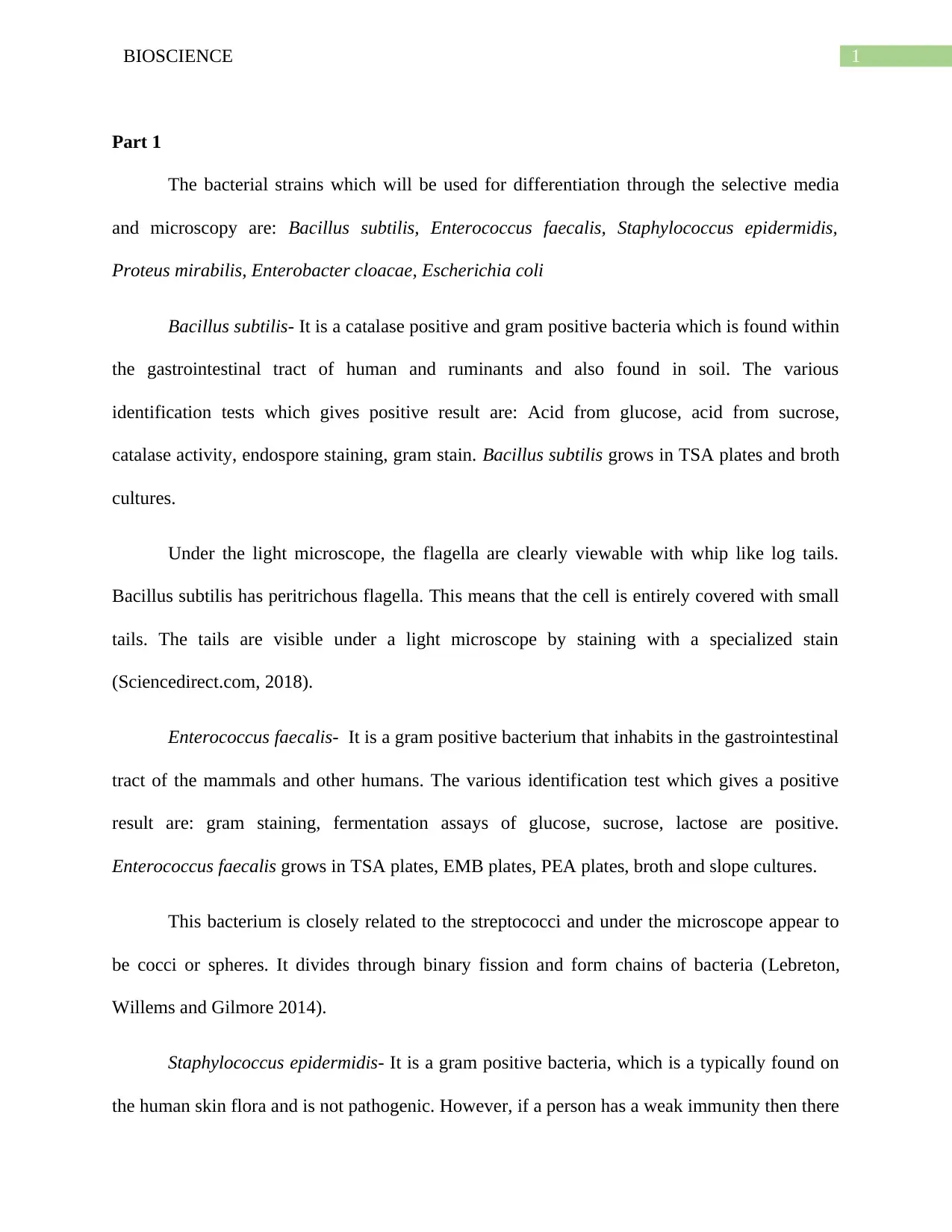
1BIOSCIENCE
Part 1
The bacterial strains which will be used for differentiation through the selective media
and microscopy are: Bacillus subtilis, Enterococcus faecalis, Staphylococcus epidermidis,
Proteus mirabilis, Enterobacter cloacae, Escherichia coli
Bacillus subtilis- It is a catalase positive and gram positive bacteria which is found within
the gastrointestinal tract of human and ruminants and also found in soil. The various
identification tests which gives positive result are: Acid from glucose, acid from sucrose,
catalase activity, endospore staining, gram stain. Bacillus subtilis grows in TSA plates and broth
cultures.
Under the light microscope, the flagella are clearly viewable with whip like log tails.
Bacillus subtilis has peritrichous flagella. This means that the cell is entirely covered with small
tails. The tails are visible under a light microscope by staining with a specialized stain
(Sciencedirect.com, 2018).
Enterococcus faecalis- It is a gram positive bacterium that inhabits in the gastrointestinal
tract of the mammals and other humans. The various identification test which gives a positive
result are: gram staining, fermentation assays of glucose, sucrose, lactose are positive.
Enterococcus faecalis grows in TSA plates, EMB plates, PEA plates, broth and slope cultures.
This bacterium is closely related to the streptococci and under the microscope appear to
be cocci or spheres. It divides through binary fission and form chains of bacteria (Lebreton,
Willems and Gilmore 2014).
Staphylococcus epidermidis- It is a gram positive bacteria, which is a typically found on
the human skin flora and is not pathogenic. However, if a person has a weak immunity then there
Part 1
The bacterial strains which will be used for differentiation through the selective media
and microscopy are: Bacillus subtilis, Enterococcus faecalis, Staphylococcus epidermidis,
Proteus mirabilis, Enterobacter cloacae, Escherichia coli
Bacillus subtilis- It is a catalase positive and gram positive bacteria which is found within
the gastrointestinal tract of human and ruminants and also found in soil. The various
identification tests which gives positive result are: Acid from glucose, acid from sucrose,
catalase activity, endospore staining, gram stain. Bacillus subtilis grows in TSA plates and broth
cultures.
Under the light microscope, the flagella are clearly viewable with whip like log tails.
Bacillus subtilis has peritrichous flagella. This means that the cell is entirely covered with small
tails. The tails are visible under a light microscope by staining with a specialized stain
(Sciencedirect.com, 2018).
Enterococcus faecalis- It is a gram positive bacterium that inhabits in the gastrointestinal
tract of the mammals and other humans. The various identification test which gives a positive
result are: gram staining, fermentation assays of glucose, sucrose, lactose are positive.
Enterococcus faecalis grows in TSA plates, EMB plates, PEA plates, broth and slope cultures.
This bacterium is closely related to the streptococci and under the microscope appear to
be cocci or spheres. It divides through binary fission and form chains of bacteria (Lebreton,
Willems and Gilmore 2014).
Staphylococcus epidermidis- It is a gram positive bacteria, which is a typically found on
the human skin flora and is not pathogenic. However, if a person has a weak immunity then there
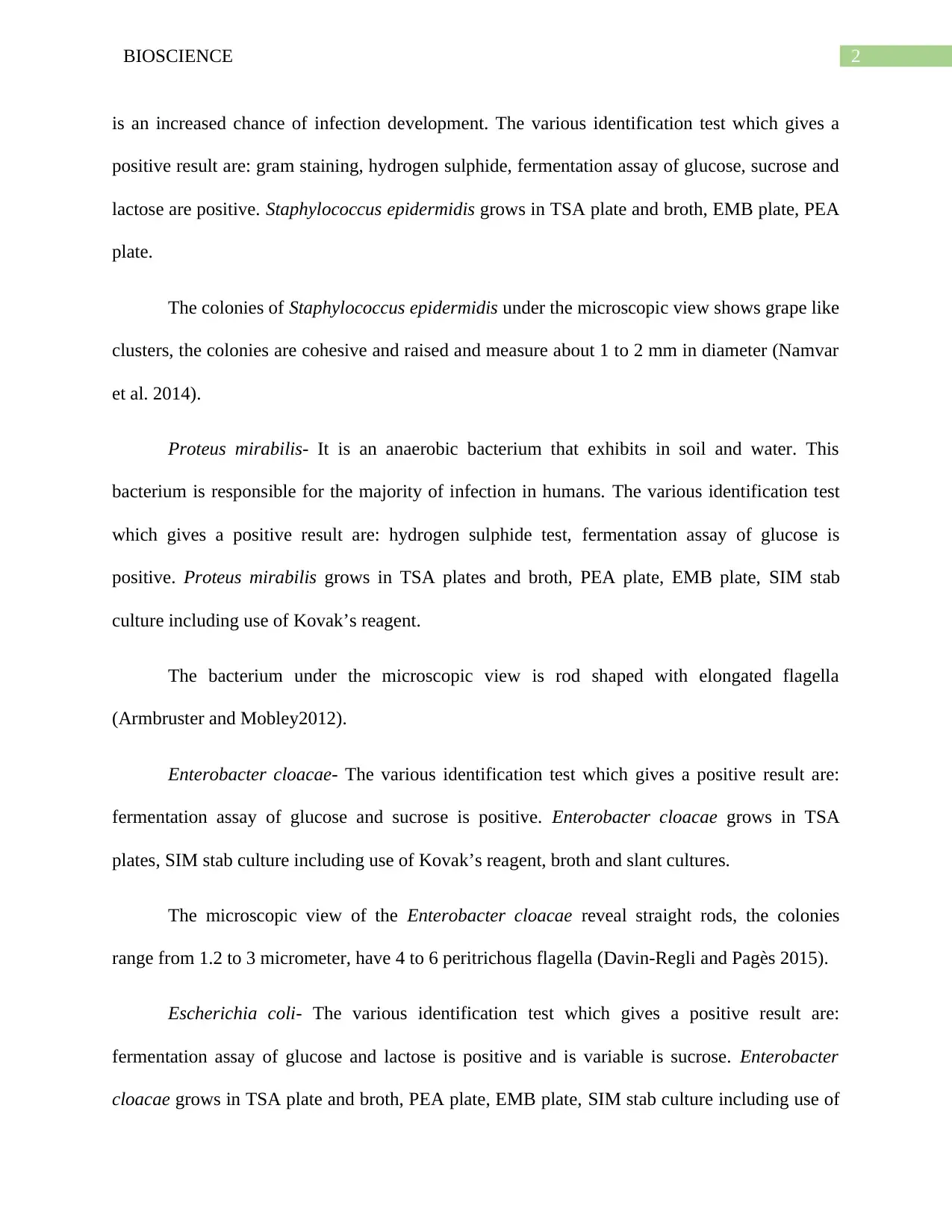
2BIOSCIENCE
is an increased chance of infection development. The various identification test which gives a
positive result are: gram staining, hydrogen sulphide, fermentation assay of glucose, sucrose and
lactose are positive. Staphylococcus epidermidis grows in TSA plate and broth, EMB plate, PEA
plate.
The colonies of Staphylococcus epidermidis under the microscopic view shows grape like
clusters, the colonies are cohesive and raised and measure about 1 to 2 mm in diameter (Namvar
et al. 2014).
Proteus mirabilis- It is an anaerobic bacterium that exhibits in soil and water. This
bacterium is responsible for the majority of infection in humans. The various identification test
which gives a positive result are: hydrogen sulphide test, fermentation assay of glucose is
positive. Proteus mirabilis grows in TSA plates and broth, PEA plate, EMB plate, SIM stab
culture including use of Kovak’s reagent.
The bacterium under the microscopic view is rod shaped with elongated flagella
(Armbruster and Mobley2012).
Enterobacter cloacae- The various identification test which gives a positive result are:
fermentation assay of glucose and sucrose is positive. Enterobacter cloacae grows in TSA
plates, SIM stab culture including use of Kovak’s reagent, broth and slant cultures.
The microscopic view of the Enterobacter cloacae reveal straight rods, the colonies
range from 1.2 to 3 micrometer, have 4 to 6 peritrichous flagella (Davin-Regli and Pagès 2015).
Escherichia coli- The various identification test which gives a positive result are:
fermentation assay of glucose and lactose is positive and is variable is sucrose. Enterobacter
cloacae grows in TSA plate and broth, PEA plate, EMB plate, SIM stab culture including use of
is an increased chance of infection development. The various identification test which gives a
positive result are: gram staining, hydrogen sulphide, fermentation assay of glucose, sucrose and
lactose are positive. Staphylococcus epidermidis grows in TSA plate and broth, EMB plate, PEA
plate.
The colonies of Staphylococcus epidermidis under the microscopic view shows grape like
clusters, the colonies are cohesive and raised and measure about 1 to 2 mm in diameter (Namvar
et al. 2014).
Proteus mirabilis- It is an anaerobic bacterium that exhibits in soil and water. This
bacterium is responsible for the majority of infection in humans. The various identification test
which gives a positive result are: hydrogen sulphide test, fermentation assay of glucose is
positive. Proteus mirabilis grows in TSA plates and broth, PEA plate, EMB plate, SIM stab
culture including use of Kovak’s reagent.
The bacterium under the microscopic view is rod shaped with elongated flagella
(Armbruster and Mobley2012).
Enterobacter cloacae- The various identification test which gives a positive result are:
fermentation assay of glucose and sucrose is positive. Enterobacter cloacae grows in TSA
plates, SIM stab culture including use of Kovak’s reagent, broth and slant cultures.
The microscopic view of the Enterobacter cloacae reveal straight rods, the colonies
range from 1.2 to 3 micrometer, have 4 to 6 peritrichous flagella (Davin-Regli and Pagès 2015).
Escherichia coli- The various identification test which gives a positive result are:
fermentation assay of glucose and lactose is positive and is variable is sucrose. Enterobacter
cloacae grows in TSA plate and broth, PEA plate, EMB plate, SIM stab culture including use of
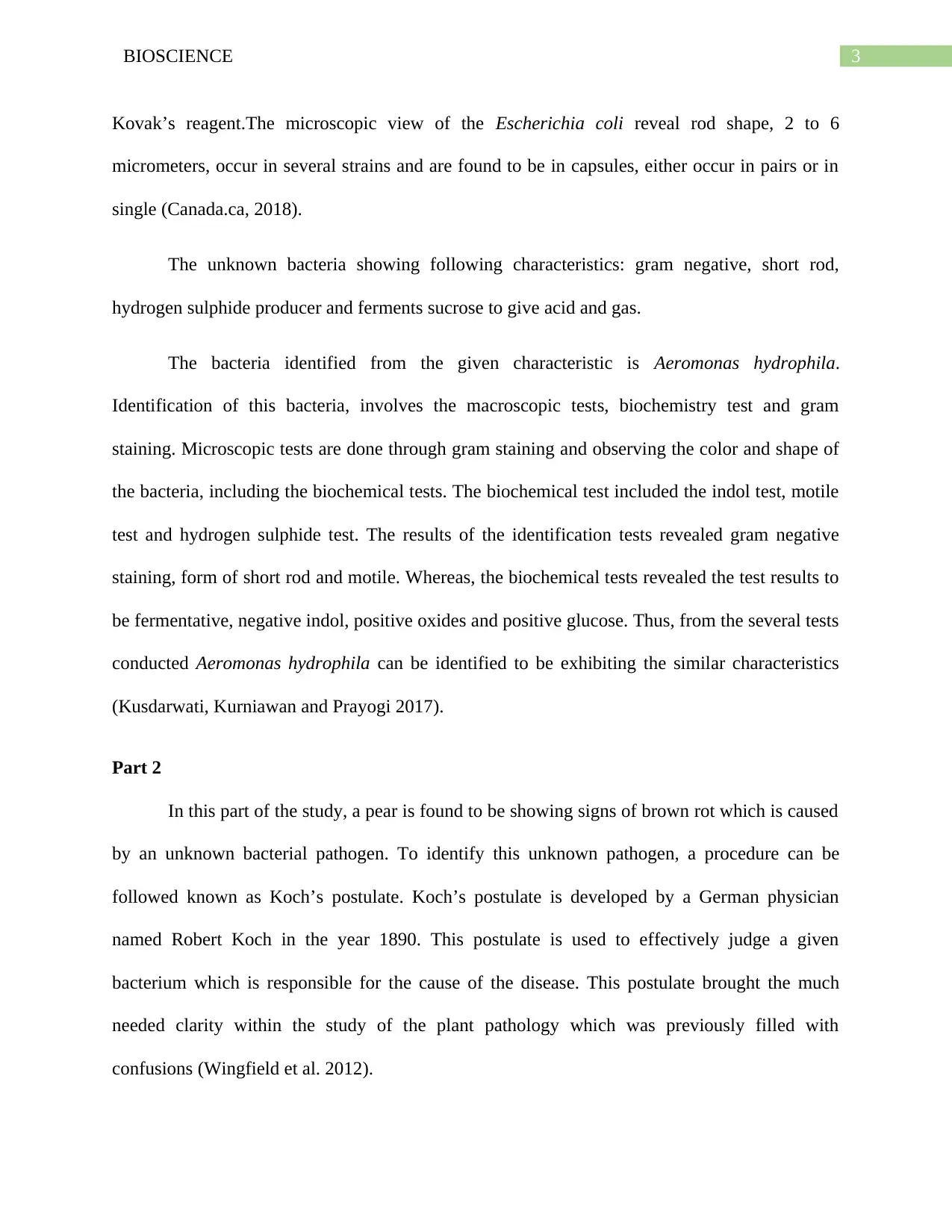
3BIOSCIENCE
Kovak’s reagent.The microscopic view of the Escherichia coli reveal rod shape, 2 to 6
micrometers, occur in several strains and are found to be in capsules, either occur in pairs or in
single (Canada.ca, 2018).
The unknown bacteria showing following characteristics: gram negative, short rod,
hydrogen sulphide producer and ferments sucrose to give acid and gas.
The bacteria identified from the given characteristic is Aeromonas hydrophila.
Identification of this bacteria, involves the macroscopic tests, biochemistry test and gram
staining. Microscopic tests are done through gram staining and observing the color and shape of
the bacteria, including the biochemical tests. The biochemical test included the indol test, motile
test and hydrogen sulphide test. The results of the identification tests revealed gram negative
staining, form of short rod and motile. Whereas, the biochemical tests revealed the test results to
be fermentative, negative indol, positive oxides and positive glucose. Thus, from the several tests
conducted Aeromonas hydrophila can be identified to be exhibiting the similar characteristics
(Kusdarwati, Kurniawan and Prayogi 2017).
Part 2
In this part of the study, a pear is found to be showing signs of brown rot which is caused
by an unknown bacterial pathogen. To identify this unknown pathogen, a procedure can be
followed known as Koch’s postulate. Koch’s postulate is developed by a German physician
named Robert Koch in the year 1890. This postulate is used to effectively judge a given
bacterium which is responsible for the cause of the disease. This postulate brought the much
needed clarity within the study of the plant pathology which was previously filled with
confusions (Wingfield et al. 2012).
Kovak’s reagent.The microscopic view of the Escherichia coli reveal rod shape, 2 to 6
micrometers, occur in several strains and are found to be in capsules, either occur in pairs or in
single (Canada.ca, 2018).
The unknown bacteria showing following characteristics: gram negative, short rod,
hydrogen sulphide producer and ferments sucrose to give acid and gas.
The bacteria identified from the given characteristic is Aeromonas hydrophila.
Identification of this bacteria, involves the macroscopic tests, biochemistry test and gram
staining. Microscopic tests are done through gram staining and observing the color and shape of
the bacteria, including the biochemical tests. The biochemical test included the indol test, motile
test and hydrogen sulphide test. The results of the identification tests revealed gram negative
staining, form of short rod and motile. Whereas, the biochemical tests revealed the test results to
be fermentative, negative indol, positive oxides and positive glucose. Thus, from the several tests
conducted Aeromonas hydrophila can be identified to be exhibiting the similar characteristics
(Kusdarwati, Kurniawan and Prayogi 2017).
Part 2
In this part of the study, a pear is found to be showing signs of brown rot which is caused
by an unknown bacterial pathogen. To identify this unknown pathogen, a procedure can be
followed known as Koch’s postulate. Koch’s postulate is developed by a German physician
named Robert Koch in the year 1890. This postulate is used to effectively judge a given
bacterium which is responsible for the cause of the disease. This postulate brought the much
needed clarity within the study of the plant pathology which was previously filled with
confusions (Wingfield et al. 2012).
Secure Best Marks with AI Grader
Need help grading? Try our AI Grader for instant feedback on your assignments.
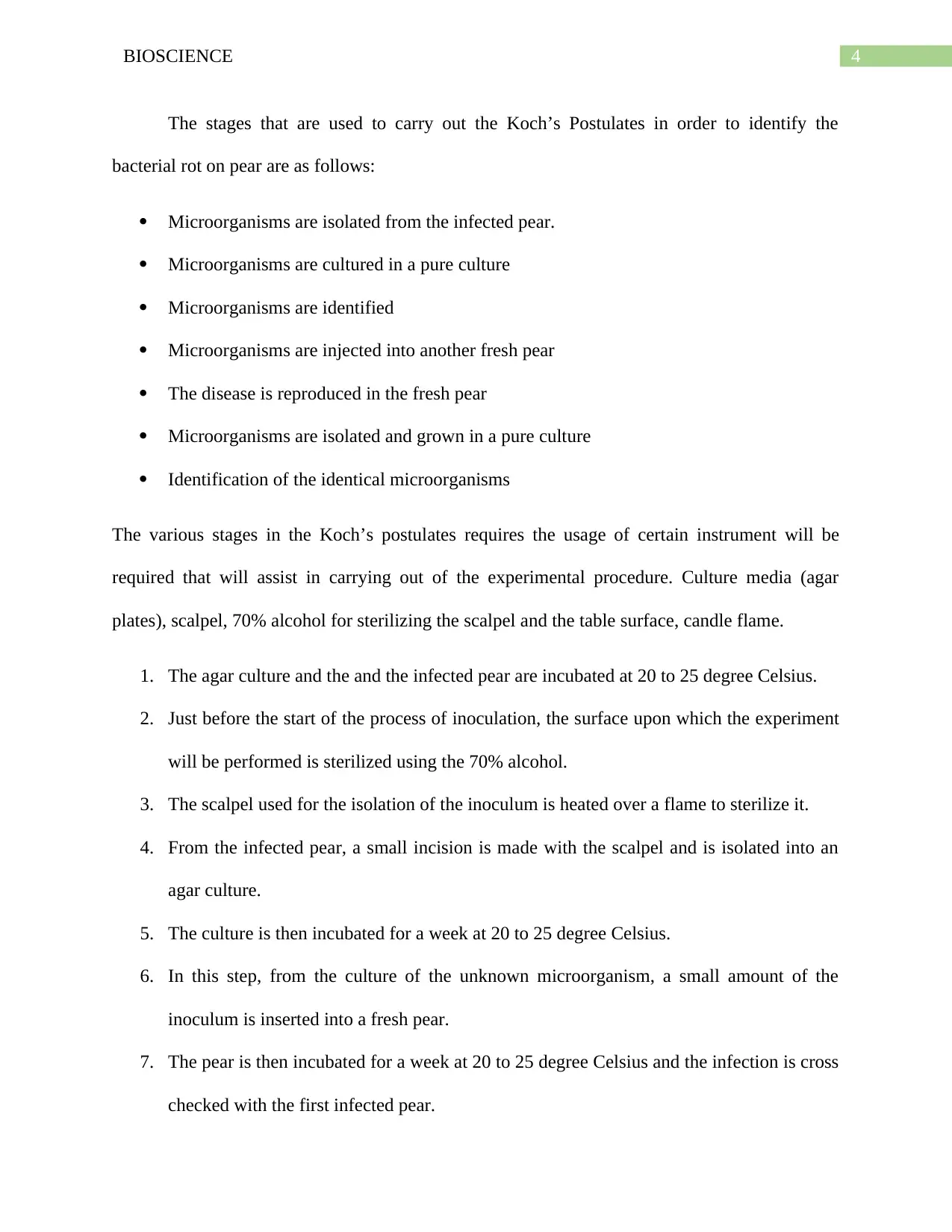
4BIOSCIENCE
The stages that are used to carry out the Koch’s Postulates in order to identify the
bacterial rot on pear are as follows:
Microorganisms are isolated from the infected pear.
Microorganisms are cultured in a pure culture
Microorganisms are identified
Microorganisms are injected into another fresh pear
The disease is reproduced in the fresh pear
Microorganisms are isolated and grown in a pure culture
Identification of the identical microorganisms
The various stages in the Koch’s postulates requires the usage of certain instrument will be
required that will assist in carrying out of the experimental procedure. Culture media (agar
plates), scalpel, 70% alcohol for sterilizing the scalpel and the table surface, candle flame.
1. The agar culture and the and the infected pear are incubated at 20 to 25 degree Celsius.
2. Just before the start of the process of inoculation, the surface upon which the experiment
will be performed is sterilized using the 70% alcohol.
3. The scalpel used for the isolation of the inoculum is heated over a flame to sterilize it.
4. From the infected pear, a small incision is made with the scalpel and is isolated into an
agar culture.
5. The culture is then incubated for a week at 20 to 25 degree Celsius.
6. In this step, from the culture of the unknown microorganism, a small amount of the
inoculum is inserted into a fresh pear.
7. The pear is then incubated for a week at 20 to 25 degree Celsius and the infection is cross
checked with the first infected pear.
The stages that are used to carry out the Koch’s Postulates in order to identify the
bacterial rot on pear are as follows:
Microorganisms are isolated from the infected pear.
Microorganisms are cultured in a pure culture
Microorganisms are identified
Microorganisms are injected into another fresh pear
The disease is reproduced in the fresh pear
Microorganisms are isolated and grown in a pure culture
Identification of the identical microorganisms
The various stages in the Koch’s postulates requires the usage of certain instrument will be
required that will assist in carrying out of the experimental procedure. Culture media (agar
plates), scalpel, 70% alcohol for sterilizing the scalpel and the table surface, candle flame.
1. The agar culture and the and the infected pear are incubated at 20 to 25 degree Celsius.
2. Just before the start of the process of inoculation, the surface upon which the experiment
will be performed is sterilized using the 70% alcohol.
3. The scalpel used for the isolation of the inoculum is heated over a flame to sterilize it.
4. From the infected pear, a small incision is made with the scalpel and is isolated into an
agar culture.
5. The culture is then incubated for a week at 20 to 25 degree Celsius.
6. In this step, from the culture of the unknown microorganism, a small amount of the
inoculum is inserted into a fresh pear.
7. The pear is then incubated for a week at 20 to 25 degree Celsius and the infection is cross
checked with the first infected pear.

5BIOSCIENCE
8. When the comparison between the two infection in different pear is established, then it
can be confirmed that the causal organism is similar (Barak and Schroeder 2012).
The pathogen which is causing the brown rot in pear is found to be a fungi called
Monilinia laxa (Poniatowska, Michalecka and Bielenin 2013).
8. When the comparison between the two infection in different pear is established, then it
can be confirmed that the causal organism is similar (Barak and Schroeder 2012).
The pathogen which is causing the brown rot in pear is found to be a fungi called
Monilinia laxa (Poniatowska, Michalecka and Bielenin 2013).
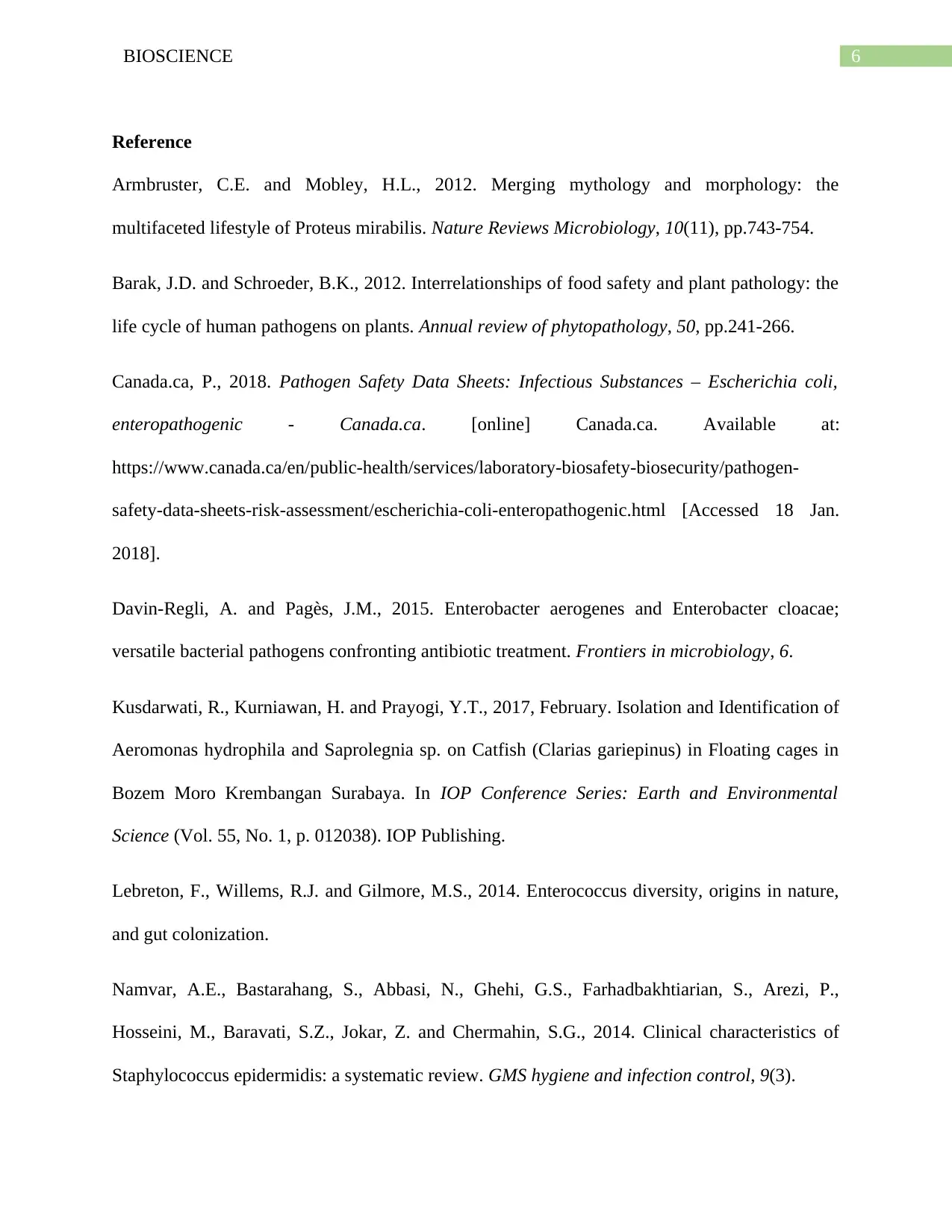
6BIOSCIENCE
Reference
Armbruster, C.E. and Mobley, H.L., 2012. Merging mythology and morphology: the
multifaceted lifestyle of Proteus mirabilis. Nature Reviews Microbiology, 10(11), pp.743-754.
Barak, J.D. and Schroeder, B.K., 2012. Interrelationships of food safety and plant pathology: the
life cycle of human pathogens on plants. Annual review of phytopathology, 50, pp.241-266.
Canada.ca, P., 2018. Pathogen Safety Data Sheets: Infectious Substances – Escherichia coli,
enteropathogenic - Canada.ca. [online] Canada.ca. Available at:
https://www.canada.ca/en/public-health/services/laboratory-biosafety-biosecurity/pathogen-
safety-data-sheets-risk-assessment/escherichia-coli-enteropathogenic.html [Accessed 18 Jan.
2018].
Davin-Regli, A. and Pagès, J.M., 2015. Enterobacter aerogenes and Enterobacter cloacae;
versatile bacterial pathogens confronting antibiotic treatment. Frontiers in microbiology, 6.
Kusdarwati, R., Kurniawan, H. and Prayogi, Y.T., 2017, February. Isolation and Identification of
Aeromonas hydrophila and Saprolegnia sp. on Catfish (Clarias gariepinus) in Floating cages in
Bozem Moro Krembangan Surabaya. In IOP Conference Series: Earth and Environmental
Science (Vol. 55, No. 1, p. 012038). IOP Publishing.
Lebreton, F., Willems, R.J. and Gilmore, M.S., 2014. Enterococcus diversity, origins in nature,
and gut colonization.
Namvar, A.E., Bastarahang, S., Abbasi, N., Ghehi, G.S., Farhadbakhtiarian, S., Arezi, P.,
Hosseini, M., Baravati, S.Z., Jokar, Z. and Chermahin, S.G., 2014. Clinical characteristics of
Staphylococcus epidermidis: a systematic review. GMS hygiene and infection control, 9(3).
Reference
Armbruster, C.E. and Mobley, H.L., 2012. Merging mythology and morphology: the
multifaceted lifestyle of Proteus mirabilis. Nature Reviews Microbiology, 10(11), pp.743-754.
Barak, J.D. and Schroeder, B.K., 2012. Interrelationships of food safety and plant pathology: the
life cycle of human pathogens on plants. Annual review of phytopathology, 50, pp.241-266.
Canada.ca, P., 2018. Pathogen Safety Data Sheets: Infectious Substances – Escherichia coli,
enteropathogenic - Canada.ca. [online] Canada.ca. Available at:
https://www.canada.ca/en/public-health/services/laboratory-biosafety-biosecurity/pathogen-
safety-data-sheets-risk-assessment/escherichia-coli-enteropathogenic.html [Accessed 18 Jan.
2018].
Davin-Regli, A. and Pagès, J.M., 2015. Enterobacter aerogenes and Enterobacter cloacae;
versatile bacterial pathogens confronting antibiotic treatment. Frontiers in microbiology, 6.
Kusdarwati, R., Kurniawan, H. and Prayogi, Y.T., 2017, February. Isolation and Identification of
Aeromonas hydrophila and Saprolegnia sp. on Catfish (Clarias gariepinus) in Floating cages in
Bozem Moro Krembangan Surabaya. In IOP Conference Series: Earth and Environmental
Science (Vol. 55, No. 1, p. 012038). IOP Publishing.
Lebreton, F., Willems, R.J. and Gilmore, M.S., 2014. Enterococcus diversity, origins in nature,
and gut colonization.
Namvar, A.E., Bastarahang, S., Abbasi, N., Ghehi, G.S., Farhadbakhtiarian, S., Arezi, P.,
Hosseini, M., Baravati, S.Z., Jokar, Z. and Chermahin, S.G., 2014. Clinical characteristics of
Staphylococcus epidermidis: a systematic review. GMS hygiene and infection control, 9(3).
Paraphrase This Document
Need a fresh take? Get an instant paraphrase of this document with our AI Paraphraser
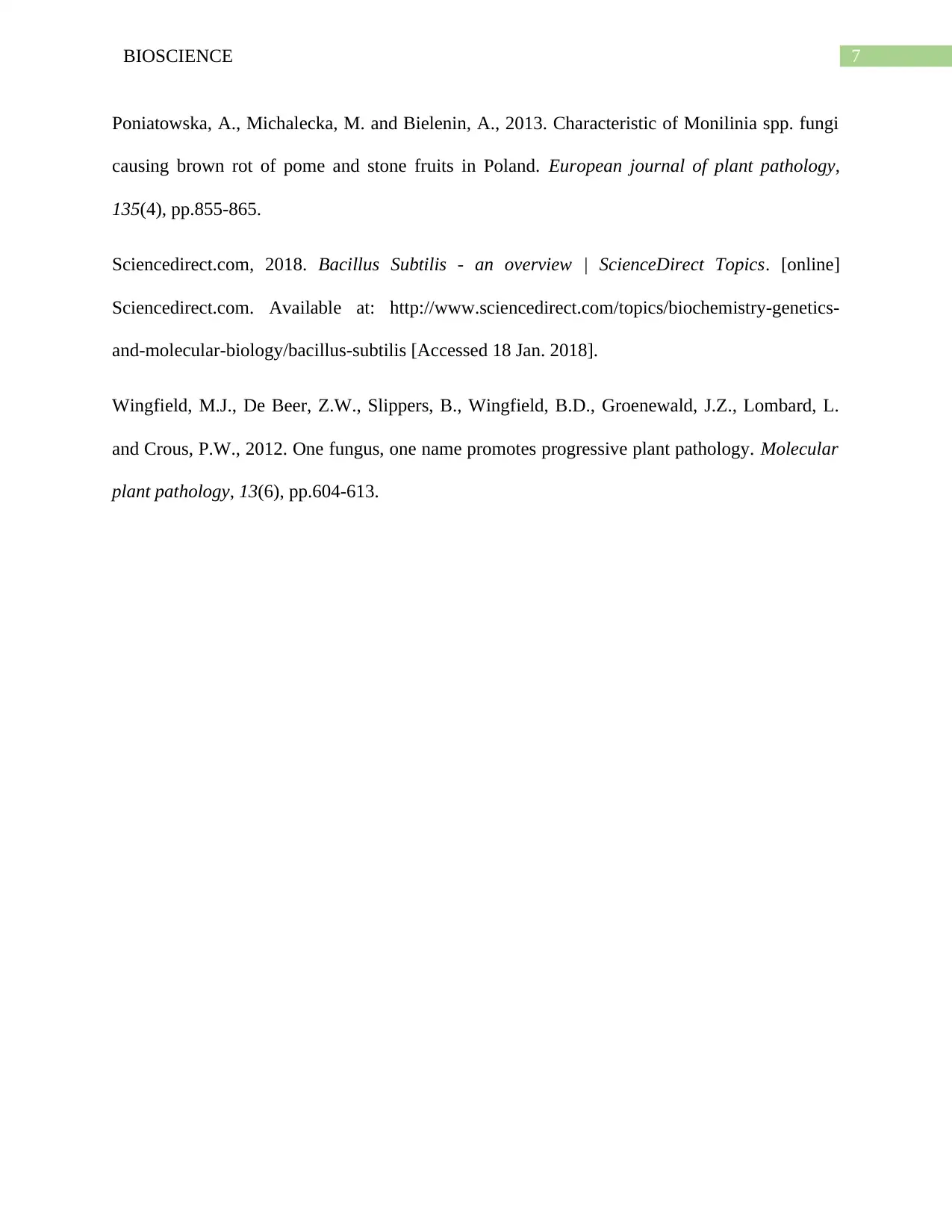
7BIOSCIENCE
Poniatowska, A., Michalecka, M. and Bielenin, A., 2013. Characteristic of Monilinia spp. fungi
causing brown rot of pome and stone fruits in Poland. European journal of plant pathology,
135(4), pp.855-865.
Sciencedirect.com, 2018. Bacillus Subtilis - an overview | ScienceDirect Topics. [online]
Sciencedirect.com. Available at: http://www.sciencedirect.com/topics/biochemistry-genetics-
and-molecular-biology/bacillus-subtilis [Accessed 18 Jan. 2018].
Wingfield, M.J., De Beer, Z.W., Slippers, B., Wingfield, B.D., Groenewald, J.Z., Lombard, L.
and Crous, P.W., 2012. One fungus, one name promotes progressive plant pathology. Molecular
plant pathology, 13(6), pp.604-613.
Poniatowska, A., Michalecka, M. and Bielenin, A., 2013. Characteristic of Monilinia spp. fungi
causing brown rot of pome and stone fruits in Poland. European journal of plant pathology,
135(4), pp.855-865.
Sciencedirect.com, 2018. Bacillus Subtilis - an overview | ScienceDirect Topics. [online]
Sciencedirect.com. Available at: http://www.sciencedirect.com/topics/biochemistry-genetics-
and-molecular-biology/bacillus-subtilis [Accessed 18 Jan. 2018].
Wingfield, M.J., De Beer, Z.W., Slippers, B., Wingfield, B.D., Groenewald, J.Z., Lombard, L.
and Crous, P.W., 2012. One fungus, one name promotes progressive plant pathology. Molecular
plant pathology, 13(6), pp.604-613.
1 out of 8
Related Documents
Your All-in-One AI-Powered Toolkit for Academic Success.
+13062052269
info@desklib.com
Available 24*7 on WhatsApp / Email
![[object Object]](/_next/static/media/star-bottom.7253800d.svg)
Unlock your academic potential
© 2024 | Zucol Services PVT LTD | All rights reserved.
